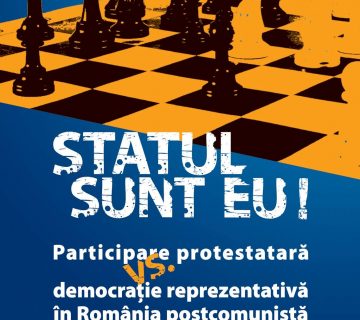1. Introduction
Nicolae Gheorghe, the father of Roma activism and a recipient of several human rights awards,[1] was born into a Roma family on November 12, 1946, in Roşiorii de Vede, Teleorman County. Due to some experiences during World War II, when his mother was nearly deported for being Roma, Nicolae’s parents tried to “escape the burden of ethnicity,” often forbidding him from playing with other Roma children. In 1955, Nicolae and his family moved to Bucharest, where they continued to hide their ethnic origins.[2]
Nicolae Gheorghe began to reconsider his ethnic identity when he met the Cioabă family, a Roma family of coppersmiths, from whom he also learned the Romani language. He stated that his interest in Roma issues was intertwined with the communist regime’s intention to adopt a nationalist policy that emphasized ethnic differences among Romanian citizens. This significantly influenced Nicolae’s research agenda. A colleague from the Sociological Research Centre noted in a report to the Security that until recently, Nicolae had not openly identified as Roma or shown interest in Roma issues. However, since 1982, he had grown a moustache and frequently spoke Romani on the phone, expressing dissatisfaction with the treatment of Roma and trying to demonstrate that Roma integration into Romanian society was incomplete.[3]
In 1983, Nicolae wrote a study in which he attempted to demonstrate that the social integration of Roma in the Socialist Republic of Romania was incomplete. Thus, this article will aim to partially or fully present the arguments Nicolae used to prove that Roma integration was unequal compared to other ethnic groups.
2. Who Were the Roma According to Nicolae?
Nicolae considered the Roma[4] an inseparable part of the population, as they were deeply attached to the Romanian territory, the state, and the socialist nation of Romania. Therefore, the future situation of the Roma should have been one of full social integration into society and the Romanian socialist nation, provided they maintained awareness of their ethnic origin and specific cultural characteristics.[5]
Nicolae noted that the distinct history of the Roma in Romanian society, the class structure, and the contradictions of feudal and capitalist societies had allowed the process of social integration of the Roma to remain incomplete. The nearly five centuries of slavery (from the first documented evidence in 1385 until 1856, when private slaves were liberated[6]) and the discrimination during the capitalist period caused the Roma to lag behind other members of society. ‘They constituted an ethnic and social category with a lower position in the social hierarchy, socially isolated, with acute manifestations of the “culture of poverty,” and low social prestige.’[7]
However, this social, cultural, and demographic isolation allowed for the formation of large, relatively well-organized Roma communities, socially and residentially segregated, with somewhat distinct norms and organizational rules, as well as the preservation of their language and some specific customs. These constituted the objective social bases for the formation and preservation of Roma ethnicity, consisting of a specific, distinct combination of lower social status characteristics with certain cultural and physical appearance peculiarities.
Nicolae believed that maintaining social distance between the Roma and the majority population was due to negative stereotypes about the Roma and their being regarded as a foreign ethnic element. This distance increased further during the interwar period, culminating in the adherence of Romanian intellectuals to fascist ideologies, which led to heightened ethnic and racial discrimination against the Roma. This new wave of hatred against the Roma culminated in the deportation of many of them to camps in Transnistria.[8]
3. How Did Nicolae Gheorghe Define the Roma Social Problem?[9]
In sociological terms, a “social problem” is defined as a situation that affects a sufficiently large number of people and is perceived by both those affected and those around them as a source of difficulty and dissatisfaction. Such a situation is believed to be solvable or improvable. A social problem has both an objective and a subjective aspect, stemming from the confrontation of values held by different social groups regarding that situation.
Therefore, the Roma social problem was understood as those demographic, cultural, occupational, lifestyle, and behavioural characteristics that were felt by both the Roma and the general public (ordinary people and representatives of public organizations) to be in discord with some of the general values and principles of the socialist society.
Thus, each stage of the multifaceted development of socialist society made it possible to address and resolve, in the spirit of deepening socialist democracy, deeper and more complex aspects and issues of relations between social categories and members of socialist society. One such relatively complex and inefficiently resolved issue was the ethnic status of the Roma and their full social integration into the institutions and culture of Romanian socialist society.
The implicit theoretical premise of this social policy was that the Roma did not constitute a distinct “nationality” or “ethnicity,” as they did not have their own culture expressed in material and spiritual “cultural works” that would express their specificity. The Roma were more likely to represent a social stratum with characteristics determined by past poverty.
General Social Characteristics of Roma in Romania
Even in these areas, however, we encounter the “enigma” of this population, as both past and present statistical data are quite limited and approximate. Until 1930, there was no official record of them, so statistical information is available only starting from this significant census of 1930. Based on literature and the censuses of 1930, 1956, 1966, and 1977 we can present the following data on the evolution of the number of Roma:
The Evolution of the Number of Roma in the Romanian Principalities and Romania from 1837 to 1977
| Source | Year | Geographical Region | Total | % of the Country’s Population | |
| 1. | M. Kogălniceanu (work on Roma) | 1837 | The Principalities | 100,000 | |
| 2. | Calsan (author of a writing on the Principalities) | 1839 | The Principalities | 257,165 | |
| 3. | Heigesener (author of a writing on the Principalities) | 1840 | The Principalities | 350,000 | |
| 4. | L Kövasy | 1847 | Transylvania | 50,000 | |
| 5. | Census in Hungary | 1857 | Transylvania | 74,360 | |
| 6. | General Population Census in Romania | 1930 | Romania | 243,000 | 1.7% |
| 7. | General Population Census | 1956 | Romania | 104,216 | 0.6% |
| 8. | General Population Census | 1966 | Romania | 64,197 | 0.3% |
| 9. | General Population Census | 1977 | Romania | 229,897 | 1.067% |
Any comment on the numerical evolution of the Roma must consider that these figures, especially those from censuses, represent the number of people who self-identified as Roma.
The negative connotations of the term “Gypsy” led some Roma to declare a different nationality, often Romanian, but sometimes Hungarian or even German. However, it was not always a matter of “hiding” their ethnicity: many of those who assimilated the occupational, educational, linguistic, and lifestyle attributes of the majority population considered themselves Romanian and aspired to be identified as such by others in their communities or workplaces. Moreover, the “Gypsy” nationality itself is not without ambiguities, making self-identification and declaration difficult.
Given these nuances, it should be noted that the phenomenon of declaring a different nationality is quite widespread among the Roma. Otherwise, we could not explain the significant variations in the number of Roma from one census to another, especially the “increase” from 64,197 in 1966 to 229,896 in 1977. The fully democratic nature of the 1977 census, the success of the PCR’s policy on national issues in the previous decade, and the propaganda activities before the census ensured the political and moral climate and the necessary guarantees for a more intense declaration of Roma nationality, which was no longer considered a “stigma” or a shame.
However, it is likely that even in this last census, some individuals who usually identified as Roma and were identified as such by those around them declared a different identity. Smaller-scale field surveys, compared to the census but more in-depth (as attempted in Sibiu County or as some specialized bodies like the Ministry of Interior had conducted), reported more realistic absolute numbers and proportions within the total population.
Given the approximate nature of the census data regarding the Roma, it is useful to examine certain social characteristics – residence, occupation, education – of this population based on distributions of these indicators by nationality, analysed comparatively for the years 1956 and 1966.
Distribution of the Roma Population by Urban and Rural Residence
| Total Roma population | 1930 | 1956 | 1960 | |||||||||
| 243,000 | 104,216 | 64,197 | ||||||||||
| Urban | % | Rural | % | Urban | % | Rural | % | Urban | % | Rural | % | |
| 3,700 | 15.22 | 206,000 | 84.77% | 18,808 | 17.3 | 86,108 | 82.7 | 64,197 | 17,007 | 47,190 | 73.4% | |
It is observed that in 1930, the vast majority of Roma lived in rural areas, similar to the residence model of the entire country’s population. The increase in the urban population was slow between 1950-1956 but more intense between 1956-1966; the urbanization rate in 1966 compared to 1956 was 9.2%, higher than the urbanization rate of Romanians (7.7%) and above the national average.
Regarding the geographical distribution of Roma across the country, the analysis of cartograms from the 1930, 1956, and 1966 censuses shows that Roma were present in varying percentages across all counties, with higher concentrations in central and southeastern Transylvania and counties along the Danube. Regional variations seem more related to the frequency of nationality declaration than actual density, which remains to be more accurately reflected in the 1977 census.
Distribution of the Roma Population by Occupational Categories
| Year | Total | Workers | Intellectuals/Officials | Cooperatives | Private Craftsmen | Collective Farmers | Individual Farmers |
| 1956 | 104,216 | 40.04% | 0.55% | 27.73% | 22.31% | 6.75% | 1.8% |
| 1966 | 64,197 | 47.3% | 0.5% | 16.24% | 14.6% | 30.38% | 2.6% |
The significant presence of Roma in the social categories of workers and cooperative farmers (30.38% in 1966) and craftsmen (especially private ones) indicates the inclusion of Roma in the revolutionary processes of socialist industrialization and agricultural collectivization alongside the entire population of the country, regardless of nationality.
If we analyze the increase and decrease of Roma in the main occupational categories between 1956-1966, compared to the main nationalities (in numerical terms) in the country, we obtain the following situation.
Increase, decrease in occupational categories, 1966 compared to 1956
| Category | Romanians | Hungarians | Germans | Jews | Roma |
| Workers | 17.21% | 13.24% | 1.55% | 3.67% | 6.92% |
| Cooperative Farmers | 36.83% | 28.53% | 8.67% | 0.35% | 23.65% |
| Individual Farmers | 48.77% | 38.13% | 9.35% | 0.68% | 13.75% |
The comparison should take into account the distribution in absolute values of the different nationalities in relation to occupational categories presented in the previous table. It should be noted, however, that the increase in the number of Roma in the category of workers is slower compared to the increase in the urbanization rate, both considered comparatively by nationality.
Educational preparation of the Roma population
| Year | Roma Population (12 and over) |
Level of Education Completed | |||||
| Higher Education | Technical and Specialized Schools |
Vocational and Trade Schools | General Schools (8-7 years) |
Primary Schools and Others |
|||
| 1966 | Roma | 1 | 15 | 11 | 179 | 1,236 | 41,139 |
| – | – | – | 0.42% | 2.90% | 96.61% | ||
| Total population | 328,241 | 559,380 | 452,645 | 729,477 | 1,680,443 | 11,441,062 | |
| 2.16% | 2.68% | 2.97% | 4.80% | 11.06% | 75.31% | ||
The approximate nature of the figures is evident in the educational categories and averages. Given the significant educational opportunities offered to all citizens of the country, regardless of nationality, including Roma, it is certain that the number of Roma who attended secondary and higher education, as well as vocational and trade schools, is quite large. However, those who attended such schools no longer consider themselves Roma. Hence, the low number of those who attended secondary and higher education and declared themselves of Roma nationality.
Nevertheless, it should be noted that the educational level of the Roma population, as reflected in the presented statistical data, is lower than the national average and compared to other nationalities, with the majority not surpassing primary school. This is naturally a consequence of the long period of isolation and social discrimination this population faced before World War II. Significant progress was made in the decade 1956-1965, and the data from the 1977 census will likely illustrate a broader engagement of the Roma population in educational activities.
4. Instead of Conclusions
I would like to also express some general viewpoints regarding the adoption and implementation of social policy measures for the Roma:
a. Such a social policy must be developed as an action program adopted at the central level and tailored by local authorities to suit their specific conditions.
b. A public discussion about the ethnic and social status of the Roma is indispensable; mass media and scientific publications can greatly contribute to the success of social integration measures for the Roma.
c. These measures primarily target Roma communities and their members; however, they should also be addressed to the entire community in which the Roma are a part, including the population with whom they interact.
d. The goal of social integration for the Roma is not only to combat and eliminate their negative behaviours and mentalities (low employment and education, poverty, deviance, etc.), but also to stimulate the positive contributions of the Roma to the development of the organizations and communities they belong to, in accordance with their creative potential, both individual and collective.
e. The success of social integration programs for the Roma largely depends on the participation of the Roma themselves in adopting and implementing these measures, as well as their involvement in the public and political life of the organizations and communities they are part of.
f. It would be useful to include in the PCR’s propaganda programs on the issue of nationalities some information regarding the achievements in improving the living standards of the Roma in our country, their social mobility under conditions of full equality in rights with all citizens, regardless of nationality. The economic, political, and cultural situation of the Roma in our country is superior to that of the Roma in many Western countries. Such realities deserve to be known to prevent the criticisms and distorted images presented by some foreign observers.
g. It would also be useful to establish direct contact with representatives of the international Roma organization (Romani Union), in order to understand their concerns and, more importantly, to correctly inform them about the situation of the Roma in our country.
h. The full social integration of the Roma and the redefinition of their social and ethnic prestige should be considered as long-term actions; observing positive effects will only be possible over the years, through systematic and persistent work, not without difficulties, obstacles, and contradictions generated by customs and mentalities deeply rooted in social group psychology. However, applying revolutionary humanism in this area of social relations makes it possible to boldly address the social issues of the Roma, overcome difficulties, and resolve the issue on principle.
References
Centrul de Documentare Nicolae Gheorghe, Fond: Nicolae Gheorghe, Dosar: Studii Științifice, 1977-1983.
Achim Viorel, Țiganii în istoria României (București: Editura Enciclopedică, 1998).
Negoi Ioan Valentin, Deportarea romilor din Muntenia în Transnistria (Cetatea de Scaun: Târgoviște, 2023).
Marin Manuela, Romii și regimul comunist din România. Marginalizare, integrare și opoziție (Cluj-Napoca:Mega, 2017).
Petcuț Petre, Rromii. Sclavie și Libertate. Constituirea și emanciparea unei noi categorii etnice și sociale la nord de Dunăre (Centrului Naţional de Cultură a Romilor: București, 2015).
Oana Sandu, “Bă, de ce ești tu țigan? Cum a devenit Nicolae Gheorghe părintele activismului civic rom”, DOR, 9 august 2013, https://www.dor.ro/nicolae-gheorghe-dor12/
Surse internet
NOTE
[1] https://nicolaegheorghe.ro/
[2] Oana Sandu, “Bă, de ce ești tu țigan? Cum a devenit Nicolae Gheorghe părintele activismului civic rom”, DOR, 9 august 2013, https://www.dor.ro/nicolae-gheorghe-dor12/
[3] Manuela Marin, Romii și regimul comunist din România. Marginalizare, integrare și opoziție (Cluj-Napoca: Mega, 2017), 33-34.
[4] In this article, I will use the term „Roma” although in the original text the author used predominantly the term „Gypsy”, a term that explicitly expresses a series of negative stereotypes about Roma. For this reason, the exonym „Gypsy” is only used when its use is necessary.
[5] About roma history Viorel Achim, Țiganii în istoria României, (București: Editura Enciclopedică, 1998).
[6] This can be seen in the work of Petre Petcut, Romii. Sclavie și libertate, Constituirea și emanciparea unei noi categorii etnice și sociale la nord de Dunăre (Bucharest, Centrul Național de Cultură al Romilor, 2015).
[7] Centrul de Documentare Nicolae Gheorghe, Fond: Nicolae Gheorghe, Dosar: Studii Științifice, 1977-1983.
[8] During the Second World War, over 25,000 Roma were deported to the Transnistria camps, of whom over 6,000 children and 5,000 adults died due to the poor conditions there. Ioan Valentin Negoi, The deportation of Roma from Muntenia to Transnistria, (Cetatea de Scaun: Târgoviște, 2023)
[9] In this part of the article, I have reproduced almost entirely the arguments that Nicolae brought in defining the social problem of the Roma, because the purpose of this article is to make known the way of thinking of the one who was to become the founder of the Roma movement. See in this sense: Centrul de Documentare Nicolae Gheorghe, Fond: Nicolae Gheorghe, Dosar: Studii Științifice, 1977-1983.



